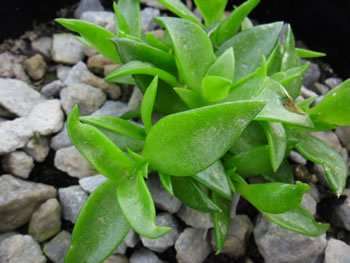Sceletium tortuosum is one of the oldest mesembs known to the western world. It is believed that Jan Van Riebeeck used to barter / trade with Sceletium. It became known to the early colonizers of the Cape in the 17th century and has been cultivated in England since 1732.
It was first described and given a Latin binomial by Carl von Linnaeus, in 1753. The Khoisan people of South Africa, who use the plant in folk medicine, introduced this mood elevating plant to the western world. In recent years, preparations from Sceletium tortuosum are commercialized as anti-depressants and to reduce anxiety. Although the plants are grown commercially on a large scale there is tremendous conservation pressure on wild harvesting of Sceletium species.
Kanna / Sceletium Plant: (information on growing sceletium from seeds)
Sceletium plants are climbers or creepers. The slender branches become thick and only slightly woody with age. Water cells are conspicuous on the leaves that have recurved tips and 3 to 5 major veins. Kanna flowers are very shortly pedicellate (almost sessile) and of medium size (20 to 30 mm diameter). Petals are white to pale yellow, pale salmon or pale pink. The calyx has four or five sepals. Fruit are 10 to 15 mm in diameter and open when wet (hygrochastic). The species is readily distinguishable by the imbricate leaves with incurved tips.
Sceletium species is considered as not threatened and is assessed as Least Concern (LC) on the Red List of South African plants.
Ranging from Namaqualand to Montagu through to Aberdeen and commonly occurs in quartz patches and is usually found growing under shrubs in partial shade.
The generic name Sceletium is derived from the Latin sceletus, referring to the prominent leaf veins that persist as the skeleton-like structure of the dry leaves. Specific name tortuosum means ‘twisted’ or ‘tortuous’.
The genus contains 8 species and is classified in the mostly weedy subfamily Mesembryanthemoideae and is easily recognized by the persistent dry leaves that become skeletonized. In dry periods, these dry leaves enclose the young leaves protecting them from harsh environmental conditions. The Afrikaans common name kougoed means ‘something to chew’. The plants are insect pollinated. Seed dispersal occurs during rain events by means of hygrochastic fruit capsules that open when wet allowing seed to escape.
Traditional Uses for Sceletium tortusoum
Sceletium tortuosum contains mesembrine and the related alkaloids mesembranol and mesembranone. Mesembrine is known for its effects on the central nervous system. The compounds also act as serotonin-uptake inhibitors, and in specified doses act as anti-depressants, minor tranquilizers and anxiolytics used in the treatment of mild to moderate depression, psychological and psychiatric disorders where anxiety is present, major depressive episodes, alcohol and drug dependence, bulimia nervosa, and obsessive-compulsive disorders (U.S.Patent 6 288 104). Smith et al. (1996) review the data about Sceletium accumulated over 300 years; they record the original folk methods for preparing Kougoed and document its psychoactive properties by reporting on the experiences of several test subjects.
Note: The Sceletium information given on this page has been derived from research.
-

Sceletium Teacut 200g
R500.00 -

Sceletium Capsules 5 Refill Packs
R450.00 -

Sceletium Capsules 10 Refill Packs
R880.00 -

Sceletium Seeds 1000
R900.00 -

Sceletium Seeds 100
R180.00 -

Sceletium Seeds 25
R60.00 -

Sceletium Seeds 10
R30.00 -

Sceletium Powder 10kg
R18,000.00 -

Sceletium Powder 3kg
R6,000.00 -

Sceletium Teacut 100g
R250.00 -

Sceletium Teacut 50g
R150.00 -

Sceletium Powder 200g
R500.00
Kanna plants are easy to grow. Read about growing your own Sceletium tortuosum at home. Please note that this is merely our way of growing this magnificent plant. There are a few factors to take in consideration when growing your own Kanna.
You can buy kanna seeds straight from our Online Shop.
Orders are shipped once the funds clears into our account, but feel free to follow up at any time to track your order.
We do not sell Sceletium plants at the moment, but we will do so in the very near future.
